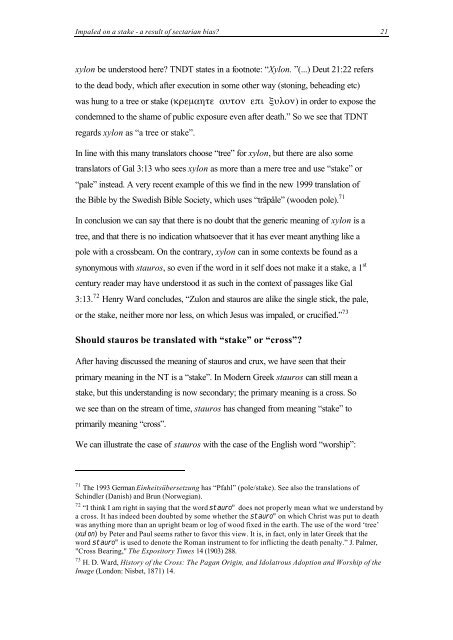Impaled on a stake — a result of sectarian bias?
You also want an ePaper? Increase the reach of your titles
YUMPU automatically turns print PDFs into web optimized ePapers that Google loves.
<str<strong>on</strong>g>Impaled</str<strong>on</strong>g> <strong>on</strong> a <strong>stake</strong> - a <strong>result</strong> <strong>of</strong> <strong>sectarian</strong> <strong>bias</strong>? 21<br />
xyl<strong>on</strong> be understood here? TNDT states in a footnote: “Xyl<strong>on</strong>. ”(...) Deut 21:22 refers<br />
to the dead body, which after executi<strong>on</strong> in some other way (st<strong>on</strong>ing, beheading etc)<br />
was hung to a tree or <strong>stake</strong> (kremahte aut<strong>on</strong> epi xul<strong>on</strong>) in order to expose the<br />
c<strong>on</strong>demned to the shame <strong>of</strong> public exposure even after death.” So we see that TDNT<br />
regards xyl<strong>on</strong> as “a tree or <strong>stake</strong>”.<br />
In line with this many translators choose “tree” for xyl<strong>on</strong>, but there are also some<br />
translators <strong>of</strong> Gal 3:13 who sees xyl<strong>on</strong> as more than a mere tree and use “<strong>stake</strong>” or<br />
“pale” instead. A very recent example <strong>of</strong> this we find in the new 1999 translati<strong>on</strong> <strong>of</strong><br />
the Bible by the Swedish Bible Society, which uses “träpåle” (wooden pole). 71<br />
In c<strong>on</strong>clusi<strong>on</strong> we can say that there is no doubt that the generic meaning <strong>of</strong> xyl<strong>on</strong> is a<br />
tree, and that there is no indicati<strong>on</strong> whatsoever that it has ever meant anything like a<br />
pole with a crossbeam. On the c<strong>on</strong>trary, xyl<strong>on</strong> can in some c<strong>on</strong>texts be found as a<br />
syn<strong>on</strong>ymous with stauros, so even if the word in it self does not make it a <strong>stake</strong>, a 1 st<br />
century reader may have understood it as such in the c<strong>on</strong>text <strong>of</strong> passages like Gal<br />
3:13. 72 Henry Ward c<strong>on</strong>cludes, “Zul<strong>on</strong> and stauros are alike the single stick, the pale,<br />
or the <strong>stake</strong>, neither more nor less, <strong>on</strong> which Jesus was impaled, or crucified.” 73<br />
Should stauros be translated with “<strong>stake</strong>” or “cross”?<br />
After having discussed the meaning <strong>of</strong> stauros and crux, we have seen that their<br />
primary meaning in the NT is a “<strong>stake</strong>”. In Modern Greek stauros can still mean a<br />
<strong>stake</strong>, but this understanding is now sec<strong>on</strong>dary; the primary meaning is a cross. So<br />
we see than <strong>on</strong> the stream <strong>of</strong> time, stauros has changed from meaning “<strong>stake</strong>” to<br />
primarily meaning “cross”.<br />
We can illustrate the case <strong>of</strong> stauros with the case <strong>of</strong> the English word “worship”:<br />
71 The 1993 German Einheitsübersetzung has “Pfahl” (pole/<strong>stake</strong>). See also the translati<strong>on</strong>s <strong>of</strong><br />
Schindler (Danish) and Brun (Norwegian).<br />
72 “I think I am right in saying that the word staurov" does not properly mean what we understand by<br />
a cross. It has indeed been doubted by some whether the staurov" <strong>on</strong> which Christ was put to death<br />
was anything more than an upright beam or log <strong>of</strong> wood fixed in the earth. The use <strong>of</strong> the word ‘tree’<br />
(xuvl<strong>on</strong>) by Peter and Paul seems rather to favor this view. It is, in fact, <strong>on</strong>ly in later Greek that the<br />
word staurov" is used to denote the Roman instrument to for inflicting the death penalty.” J. Palmer,<br />
"Cross Bearing," The Expository Times 14 (1903) 288.<br />
73 H. D. Ward, History <strong>of</strong> the Cross: The Pagan Origin, and Idolatrous Adopti<strong>on</strong> and Worship <strong>of</strong> the<br />
Image (L<strong>on</strong>d<strong>on</strong>: Nisbet, 1871) 14.



